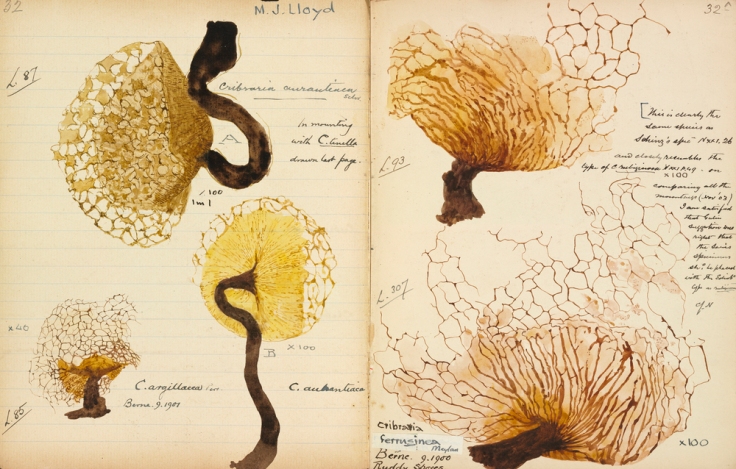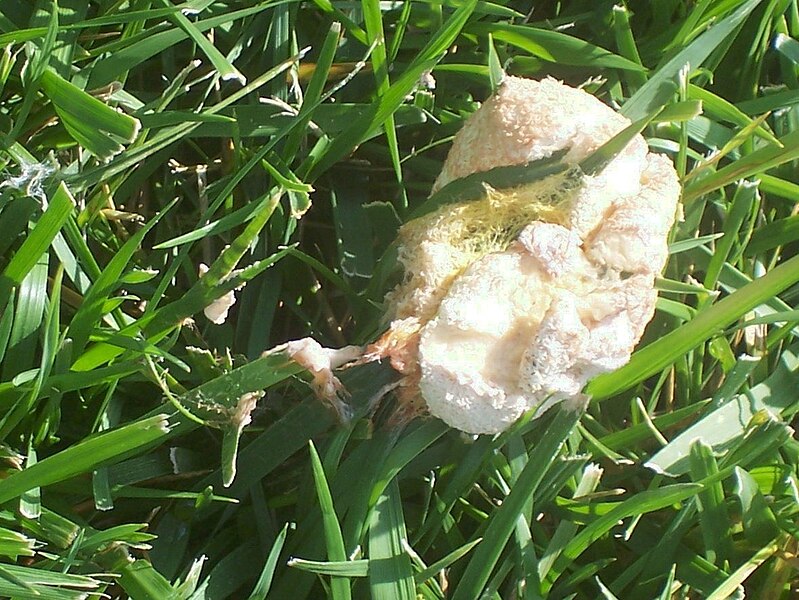I thought it would be interesting to do something different with this entry to Science Fantasy Flora and Fauna, and instead of doing three different animals or plants, I would focus on one creature that’s a bit of both: the slime mold.

Slime molds are a type of single-celled organism that can come together and move as one unit when food is scarce. Some form one giant cell with a bunch of nuclei floating around, while others remain distinct cells while in the grouping. For this article, I will mostly be sticking to the plasmodial, or one giant cell type. Once food is secure, they form fungus-like growths that then release spores that are spread by wind and insects.
They can sense food, avoid light, and some have even shown the ability to ‘remember’ regularly occurring events, such as temperature changes, and react before they happen. These behaviors seem to happen without any sort of brain, which raises interesting questions about intelligence. In a world with magic, how would such creatures develop over time?
As always, I am taking real world examples and giving them a twist, however instead of doing three examples and moving on, I want to break down some interesting characteristics of slime molds, since not many people are aware of what they are. I also want to show you how you can use these characteristics to make an interesting fantasy version for your stories and games.

Movement
Slime molds move by pulsating its ‘appendages’ and scooting forward micron by micron. They don’t move fast, but compared to plants they might as well be the Flash. Over a minute, a slime mold can move about a third of an inch, which means given eight hours, or say as long as the average humanoid sleeps, a slime mold can cover up to 12 feet. Imagine going to sleep by a sleepy brook only to wake up covered in living slime.
Movement in these slimes seems to be dictated by four things: Food, light, temperature, and humidity. Slime molds prefer warm, dark, damp places, and only come into the light when they are in the fructification phase of their life cycle when they are actively trying to spread spores.
A mold slime’s world is dark and dank, the only motivation being a constant hunger for anything it can digest. In smaller slime molds this is mostly soil bacteria and small organic matter, but, in a fantasy world such as ours, this could include animals and even people, should the slime be big enough.
Life Cycle
Spore
The spores of slime molds are the most resilient form of the creature during its life cycle. They can survive adverse temperatures and remain able to germinate for up to 75 years. Spores are released from hardened globules of slime that dry in the sun and pop open. Once they begin to germinate they bud small cells that contain one set of genes in two types: ones that swim, and ones that creep.
Swimmers and Creepers
While in these forms, cells can change between one or the other depending on the humidity. Once two of these cells of the same type meet they merge together and combine their genetic structures. This combined cell then splits into several of the plasmodium type cells that make up the creature we know as the slime mold. It’s only when there is a lack of food that these cells combine into a single organism, however, and if food is plentiful they stay separate entities.
Plasmodium
Many slime molds don’t appear to the naked eye, but once they reach enough cell mass they can be seen, ranging in looks from completely transparent to bright pink or yellow. They seem to be a viscous, shiny ooze, and move along by pulsating their mass along ‘chosen’ paths. When seeking food they spread out in fractal patterns that look like lightning strikes or tree branches.
Once the food is found they then retract the remaining mass, forming efficient pathways for transferring nutrients to the rest of the cells. They consume their prey through phagocytosis, engulfing their prey and dissolving them from within like a primitive stomach.
In Fantasy
With this in mind, imagine a cave. It is dark, damp, and thanks to geothermal vents, warm. A party of adventurers have just finished eradicating a rat infestation that had been getting into local food supplies. Unfortunately, the rat droppings and carcasses were the main food source of small single-celled organisms.
Without food, they come together and form a huge slime mold that covers the cave floor. It moves towards the nearest food source that can support its number, perhaps the nearby farm animals, and consumes them on the cellular level, leaving behind only indigestible fragments of fur and bone.
Once this food source is dry, it may enter the sporing phase, spreading its offspring via wind power, drifting over a nearby village. Once it germinates, the whole cycle continues. If it finds large amounts of nutrients, however, it could continue to grow in size. With the aid of magic, this addition of life force could provide it with greater intelligence, each additional cell acting as a logic gate that increases the complexity of responses to stimuli the slime mold is capable of making.
This interpretation of slime molds is not entirely realistic, or at least unproven, but could add quite an interesting element to your fantasy story or game. Leave me a comment if you think I got something wrong, or if you have an interesting way of implementing these creatures in your world.

Leave a comment